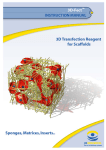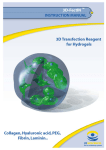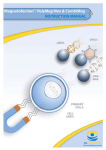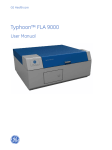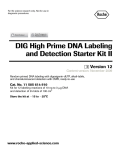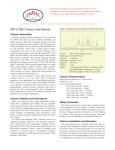Download OZ Biosciences / Protocol Magnetofection™: SelfMag Carboxy Kit vs
Transcript
OZ Biosciences / Protocol Magnetofection™: SelfMag Carboxy Kit vs. 1.4 / www.ozbiosciences.com / -0- Magnetofection™: SelfMag Carboxy Kit Instruction Manual SelfMag has been designed to couple your molecules of interest onto magnetic nanoparticles and deliver them into cells by magnetic targeting. SelfMag Carboxy Kit allows you to make your own magnetic delivery system! List of SelfMag Carboxy Kits Catalog Description Number SC20000 SelfMag Carboxy Kit1 SC21000 SC22000 SelfMag Carboxy nanoparticles Buffers Kit C2 SF40000 DM30000 MF10000 MagFectin MagID (magnetic device) Super Magnetic Plate Content Number of assays All in one Kit 1 to 50 coupling reactions 1000 delivery assays 1 mL − Buffer C1: 15mL coupling − Buffer C2: 15 mL washing/storage − 100 mg EDC 1 mL 1 unit 1 unit 1 to 50 coupling reactions 1 to 50 coupling reactions 1000 delivery assays - 1 Contains 1 vial of SelfMag Carboxy nanoparticles, 1 Buffers Kit (coupling, washing/storage buffers and EDC), 1 MagID device, 1 vial of MagFectin and one Super Magnetic Plate 2 Contains 1 bottle of coupling buffer C1, 1 bottle of washing/storage buffer C2 and 1 vial of EDC reagent. Use the content of the table above to determine the appropriate catalog number for your needs. You can order these products by contacting us (telephone, fax, mail, e-mail) or directly through our website. For all other supplementary information, do not hesitate to contact our dedicated technical support: [email protected]. OZ BIOSCIENCES Parc Scientifique et Technologique de Luminy; BP13 13273 Marseille Cedex 9, France Tel: +33 (0) 4.91.82.81.75 Fax: +33 (0) 4.91.82.81.70 E-mail: [email protected] Site Internet: www.ozbiosciences.com OZ Biosciences / Protocol Magnetofection™: SelfMag Carboxy Kit vs. 1.4 / www.ozbiosciences.com / -1- Table of Contents 1. Technology 1.1. Product Description 1.2. Physical Characteristics of SelfMag Carboxy Nanoparticles 1.3. Principle 1.4. Kit Content 1.5. Magnetic Apparatus 1.6. Storage-Stability 2. Instruction for Coupling the Molecules 2.1. General Considerations 2.2. Activation and Coupling of the Molecules 2.3. Washing and Storage of Coupled Nanoparticles 2.4. Scale up/down of the Coupling Reaction 3. Protocol for delivering Coupled SelfMag Nanoparticles into Cells 4. Example of Application 4.1. Protocol for Coupling β-Galactosidase 4.2. Intracellular Delivery of β-Galactosidase Coupled-Nanoparticles 5. Appendix 5.1. Quality Controls 5.2. Troubleshooting 6. Related Products 7. Purchaser Notification 2-4 2 2 3 3 3 4 4-6 4 4-5 5-6 6 6-7 7-8 7 7-8 8 8 8 9 10 1. Technology 1.1. Product Description Congratulations on your purchase of the SelfMag Carboxy Kit! SelfMag Carboxy nanoparticles are colloidal monodispersed superparamagnetic, which are composed of a magnetic core surrounded by a highly cross-linked polymer shell. The SelfMag surface is activated with carboxylic acid functionality (COOH) making an ideal reagent for coupling any molecules bearing an amino reactive group in order to produce your self-made magnetic delivery system. SelfMag Carboxy nanoparticles are supplied in an aqueous suspension. The hydrophilic surface of SelfMag ensures low non-specific binding, excellent dispersion abilities and easy handling in solution. Optimized coupling and washing/storing buffers, EDC (for carbodiimide activation), a magnetic device MagID for the coupling and washing procedure are also supplied. In addition, a magnetic plate that generates a magnetic field gradient and a specific delivery reagent, MagFectin, allowing the transport into cells of magnetic nanoparticles (Magnetofection) are provided. SelfMag Carboxy Kit contains all components to make in a simple and easy way your own magnetic delivery system. 1.2. Physical Characteristics of SelfMag Carboxy Nanoparticles • • • • • • • • Diameter: 160 nm (CV max 20%) Relative density: 1.25 – 1.3 Magnetic susceptibility: 35 – 37 emu.g-1 Specific surface area per carboxylic acid functionality: 34.38 Ų Iron oxide content: approx. 50% COOH density: 150 µmol.g-1 Solid content (stock solution): 1 mg/mL (0.1%) Beads concentration: 2.5 × 1011 beads per mL OZ Biosciences / Protocol Magnetofection™: SelfMag Carboxy Kit vs. 1.4 / www.ozbiosciences.com / -2- 1.3. Principle SelfMag Carboxy particles are designed as superparamagnetic, nanosized polymer particles bearing carboxy reactive groups on their surface for the coupling and the delivery of your molecules of interest into cells by magnetic targeting. Proteins, peptides, oligonucleotides, small drugs or other various molecules having reactive amino groups can be covalently coupled directly onto the surface reactive groups (COOH) of the nanoparticles and maintain their biological activity. Thereafter, the molecules coupled to the SelfMag Carboxy nanoparticles can be easily concentrated onto the target cells by exploiting the magnetic field force, and internalized within a few minutes by using a specific MagFectin reagent dedicated to the magnetic nanoparticles delivery into cells (Magnetofection). 1.4. Kit Content • • • • • 1 2 − − − 1 1 1 vial containing 1 mL of SelfMag Carboxy Nanoparticles (1 mg/mL), good for 1 to 50 coupling reactions bottles each containing 15 mL of sterile buffer solutions: Buffer C1: SelfMag Carboxy Coupling Buffer Buffer C2: SelfMag Carboxy Washing & Storage Buffer 1 vial containing 100 mg EDC vial containing 1 mL of MagFectin delivery reagent good for 1000 delivery assays. MagID (Magnetic Isolation Device) for the coupling and washing procedures. Super Magnetic Plate for delivery into cells (Magnetofection). 1.5. Magnetic Apparatus • MagID (Magnetic Isolation Device) for coupling reactions and washing procedures MagID is made from an injection moulded plastic housing incorporating a high-energy neodymium magnet. It is designed to accommodate standard 1.5 mL tubes and is also suitable for some 2 mL tubes. It is ideal for your magnetic nanoparticles coupling reaction and purification. It is adapted to working solutions ranging from 10 µL to 2 mL. This device allows a quick magnetic separation process (< 5 minutes) with a high yield separation. Durable and easy to use, this device, with an open faced design, facilitates aspiration, pipetting etc. • Super Magnetic Plate for delivery into cells As for all Magnetofection reagents, the delivery of coupled SelfMag Carboxy nanoparticles is supported by an appropriate magnetic field and the MagFectin delivery reagent. The special geometry of the Super Magnetic Plate produces a strong magnetic field that is suitable for all cell culture dishes (T-75 flasks, 60 & 100 mm dishes, 6-, 12- 24-, 48- and 96-well plates). Warning and Handling: These products should be handled with care. Avoid direct contact with other magnetic materials and devices. Person with pacemakers/implants should avoid direct contact. Keep loose ferrous material away and do not attempt to disassemble. Keep all magnetic media, watches, and sensitive electronic devices away from these magnetic apparatus. Credit cards, tape and disks can be erased in the presence of a magnetic field. Bodily harm (pinching of hands and skin) can result if magnets are not handled correctly. Maintain distance between two or more magnetic units. Product should be stored in a dry environment and should be cleaned with a damp cloth and mild detergent when exposed to harsh solvents. Do not autoclave. OZ Biosciences / Protocol Magnetofection™: SelfMag Carboxy Kit vs. 1.4 / www.ozbiosciences.com / -3- 1.6. Storage / Stability • SelfMag Carboxy nanoparticles Storage at +4ºC. Upon receipt and for long-term use, store the SelfMag nanoparticles in the fridge. The stock solution of SelfMag Carboxy nanoparticles is stable for at least one year at the recommended storage temperature. The SelfMag Carboxy beads must be maintained in liquid during storage and all handling steps. Drying will result in reduced performance. Precaution should be taken to prevent bacterial contamination of the beads. − Do not freeze the magnetic nanoparticles! − Do not add anything to the stock solution of magnetic nanoparticles! • Buffer Kits and MagFectin reagent Upon receipt and for long-term use, store sterile buffer solutions, EDC and MagFectin at +4°C. These reagents are stable for at least 1 year at the recommended storage temperature. EDC should be kept dried. • Magnetic device and plate They can be stored at room temperature (dry environment is preferred) away from any electronic, informatics or magnetic materials. Shipping condition: Room Temperature. 2. Instruction for Coupling the Molecules 2.1. General Considerations For coupling your molecules of interest on SelfMag Carboxy nanoparticles, we recommend to use between 0.5 and 5 nmol of “ligand” (molecules) per mg of SelfMag Carboxy. The nanoparticles should be used at a final concentration comprised between 0.5 and 1 mg per mL during the coupling reaction. However, protocols may be adapted to meet your requirements. Both molecules and nanoparticles concentration can be adjusted depending on the stock concentration, solubility and availability of your “ligand”. Higher nanoparticles concentrations increase the coupling efficiency, and higher “ligand” concentrations increase the number of molecules coupled onto the nanoparticles. The suggested protocol described below has been optimized for a specific application: the delivery of molecules into cells. It illustrates an example using 100 µL of SelfMag Carboxy particles at 1 mg/mL (100 µg of beads), but can be scaled up and down to suit specific needs. The “ligand” concentration was set to 10 µmol/L, but can be adapted according to your needs. It is recommended to manipulate SelfMag Carboxy nanoparticles under sterile conditions for using with cells. Important note: The nature and the ionic strength of the buffers (for coupling, washing and storage of SelfMag) are critical to obtain a high coupling efficiency rate and to avoid the nanoparticles aggregation. In this context, we highly recommend to only use the buffers provided in the kit (Buffer C1 for coupling and Buffer C2 for washing and storage) and NOT other buffers. 2.2. Activation and Coupling of the Molecules Formation of an amide bound between a primary amino group of the molecule of interest and a carboxylic acid group on the surface of the SelfMag Carboxy nanoparticles is mediated by carbodiimide activation. 1-ethyl-3-(3-dimethylaminopropyl)carbodiimide hydrochloride (EDC, MW 191.7) is the carbodiimide most commonly used. Its water solubility allows for direct addition to a reaction without prior organic solvent dissolution. The excess of reagent and the by-product (isourea) resulting from the reaction are both water-soluble and can be easily removed. A stock solution of EDC must be prepared to facilitate the addition of a small molar amount to the reaction mixture and used immediately to prevent extensive loss of activity. EDC is not stable in water and thus must be prepared freshly for each reaction. OZ Biosciences / Protocol Magnetofection™: SelfMag Carboxy Kit vs. 1.4 / www.ozbiosciences.com / -4- CH3 COOH NH2 HOOC + L H3C N C N NH L CH3 EDC HOOC COOH COOH 1. Before each use, resuspend the SelfMag Carboxy nanoparticles by pipetting up and down or by vortexing 1 minute. Avoid foaming. 2. Transfer 100 µL of the SelfMag Carboxy nanoparticles in a microtube. 3. Place the SelfMag microtube in the MagID device, let stand until the supernatant clears up and remove it by pipetting (aspiration), leaving the nanoparticles pellet undisturbed. 4. Remove the microtube from the MagID device and resuspend the SelfMag nanoparticles in 100 µL of Buffer C1 by pipetting up and down. 5. Repeat steps 3 and 4 one more time. 6. Prepare 100 µL of the molecule to be coupled (“ligand”) at a concentration of 10 µmol/L in the Buffer C1. If your molecule is already in a buffered solution, we recommend you to dialyse it against water before use, since some salts containing buffer could potentially cause the aggregation of the nanoparticles. 7. Add between 5 and 50 µL of the “ligand” solution to the 100 µL of SelfMag prepared previously. Then, vortex to ensure a good mixing and shake (agitator, mixer) the mixture 15-30 minutes at room temperature. 8. Immediately prior to use, prepare a 10X stock solution of EDC at a concentration of 10 mg/mL in water. Then, dilute 10 µL of the 10X EDC solution to 100 µL with the Buffer C1 in order to obtain a 1X EDC solution. 9. Add 5 to 10 µL of 1X EDC solution (5 to 10 µg) to the SelfMag Carboxy nanoparticles / “ligand” mixture. Vortex to ensure a good mixing. 10. Shake (agitator, mixer) the mixture for at least 2 hours at room temperature (or overnight at 4°C depending on the nature of the molecule to be coupled). 11. Then, proceed to the washing protocol as described below (2.3). 2.3. Washing and Storage of Coupled Nanoparticles All coupling procedures require washing of the molecule-conjugated SelfMag Carboxy nanoparticles to remove the excess of “ligand”, EDC and the resulting by-product (isourea). 1. Place the mixture microtube in the MagID device, let stand until the supernatant clears up and remove it by pipetting (aspiration), leaving the nanoparticles pellet undisturbed. 2. Remove the microtube from the MagID device and resuspend the SelfMag nanoparticles in 100 µL of Buffer C2 by pipeting up and down. Optionally, in order to quench the non reacted activated carboxylic acid groups, resuspend the coupled nanoparticles with 100 µL of 1 mM Tris pH 7.4 instead of Buffer C2, then shake the mixture for 15 minutes at room temperature. 3. Place the SelfMag microtube in the MagID device, let stand until the supernatant clears up and remove it by pipetting (aspiration), leaving the nanoparticles pellet undisturbed. 4. Remove the microtube from the MagID device and resuspend the SelfMag nanoparticles in 100 µL of Buffer C2 by pipeting up and down. 5. Repeat steps 3 and 4 one or two times. OZ Biosciences / Protocol Magnetofection™: SelfMag Carboxy Kit vs. 1.4 / www.ozbiosciences.com / -5- The use of MagID device avoids significant lost of nanoparticles during this procedure. Consequently, 100 µg of coupled SelfMag Carboxy nanoparticles are obtained at a final concentration of 1 mg/mL. Store the coupled nanoparticles at +4°C. Coupled SelfMag can usually be stored for several weeks at this temperature, depending on the stability of the coupled molecules. However, it is recommended to use them rapidly after coupling. For every delivery experiment, resuspend the nanoparticles by pipeting up and down prior to use. 2.4. Scale up/down of the Coupling Reaction The suggested protocol described above is provided for the coupling of 100 µg of nanoparticles. However, this protocol can be scaled up or scaled down depending on the quantity of your molecules or on your specific needs. Refer to the Table 1 below for suggested quantities of SelfMag nanoparticles, molecules to be coupled and EDC. Table 1: Quantities of SelfMag nanoparticles, molecules and reagents suggested for coupling SelfMag Carboxy nanoparticles (1 mg/mL) Solution Quantity volume (µg) (µL) Molecule to be coupled (10 µmol/L) Solution Quantity volume (mole) (µL) EDC Solution concentration (mg/mL) Quantity (mole) Solution volume (µL) Washing & Storage volume (µL) 20 20 10 – 100 pmol 1 – 10 5 – 10 nmol 1 1–2 20 50 50 25 – 250 pmol 2.5 – 25 12.5 – 25 nmol 1 2.5 – 5 50 100 100 50 – 500 pmol 5 – 50 25 – 50 nmol 1 5 – 10 100 500 500 0.25 – 2.5 nmol 25 – 250 0.13 – 0.25 µmol 10 2.5 – 5 500 1000 1000 0.5 – 5 nmol 50 - 500 0.25 – 0.5 µmol 10 5 - 10 1000 3. Protocol for Delivering Coupled SelfMag Nanoparticles into Cells The instructions given below represent a model of protocol that was applied successfully to deliver coupled nanoparticles into several cells. We recommend you to start by following this general protocol as guideline and then optimized the conditions if required. Please refer to the table 2 below as a starting point for experimental conditions. However, some optimization may be needed depending on the nature of the molecule coupled and the cell type. 1. The day prior the delivery experiment, plate the cells in your tissue culture dish. The suitable cell density will depend on the growth rate and the conditions of the cells. Cells should not be less than 60 % confluent (percentage of growth surface covered with cells) at the time of delivery (see the suggested cell number in the table 2). The correct choice of optimal plating density also depends on the planned time between delivery and analysis: for a large interval, we recommend a lower density and for a short interval a higher density may be advantageous. Table 2: Experimental conditions suggested for delivering the coupled nanoparticles into cells Tissue Culture Dish 96 well 24 well 12 well 6 well 60 mm dish 90 - 100 mm T-75 flask Cells to plate Adherent Cell Number Seeding Volume 0.05 – 0.2 x 10 5 0.5 – 1 x 10 5 1 – 2 x 10 5 2 – 5 x 10 5 5 – 10 x 10 5 10 – 30 x 10 5 20 – 50 x 10 5 150 µL 400 µL 800 µL 1.6 mL 3.2 mL 7 mL 9 mL Coupled SelfMag solution volume (µL) (C=1 µg/µL) 0.5 - 1 2-4 4-8 8 - 16 20 - 40 60 - 120 70 - 130 MagFectin diluted solution MagFectin Volume(µL) Dilution Volume (µL) 0.2 – 0.5 0.8 - 2 1.6 - 4 3-8 8 – 20 25 – 60 35 - 70 50 100 200 400 800 1000 1000 Total Volume/well 200 µL 500 µL 1 mL 2 mL 4 mL 8 mL 10 mL 2. Before each use, vortex the molecule-coupled SelfMag nanoparticles solution. Add the suggested amount of nanoparticles (see Table 2) to a microtube or microwell (U-bottom well is preferred to get a better mixing). 3. In another microtube, dilute the MagFectin delivery reagent in serum and supplement-free culture medium (see Table 2 for volume of MagFectin and dilution volume). OZ Biosciences / Protocol Magnetofection™: SelfMag Carboxy Kit vs. 1.4 / www.ozbiosciences.com / -6- 4. Add the MagFectin solution to the coupled nanoparticles and mix immediately by pipeting up and down. 5. After 20 minutes of incubation, add the complexes (coupled nanoparticles/MagFectin) to the cells. The total volumes per well (culture medium + complexes) are indicated in Table 2. 6. Place the cell culture plate upon the Super Magnetic Plate for 15-20 minutes. 7. Remove the Super Magnetic Plate. 8. Cultivate the cells under standard conditions until assays are performed (from 3 to 48 h). 4. Example of Application 4.1. Protocol for Coupling β-Galactosidase 1. Resuspend the SelfMag Carboxy nanoparticles by pipeting up and down. 2. Transfer 100 µL of the SelfMag Carboxy nanoparticles in a microtube and washed them with Buffer C1 as described in section 2.2 above. 3. Prepare 100 µL of a β-galactosidase solution at 5 µmol/L in the Buffer C1. 4. Add 50 µL (25 µg, 0.2 nmol) of the β-galactosidase solution to the 100 µL of SelfMag prepared previously. Then, vortex to ensure a good mixing and shake (agitator, mixer) the mixture 30 minutes at room temperature. 5. Prepare a 1X EDC solution (1 mg/mL) in the Buffer C1 as described in section 2.2. 6. Add 5 µL of 1X EDC solution (5 µg) to the SelfMag Carboxy nanoparticles / β-galactosidase mixture. Vortex to ensure a good mixing. 7. Shake (agitator, mixer) the mixture for 2 hours at room temperature. 8. Wash the coupled nanoparticles with Buffer C2 as described in section 2.3 above. 9. Finally, store the β-galactosidase coupled SelfMag in 100 µL of Buffer C2 at a concentration of 1 mg/mL. The amount of β-Galactosidase coupled on the SelfMag was monitored by using the ONPG β-Galactosidase assay kit (OZ Biosciences, cat# GO10001). Results showed 0.45 pmol (54 ng) of linked β-Galactosidase per µg of nanoparticles which correspond to a coupling efficiency of 23%. Efficiency can be optimized by varying various parameters such as incubation time, β-Galactosidase concentration, nanoparticles quantity and incubation temperature. 4.2. Intracellular Delivery of β-Galactosidase Coupled Nanoparticles The instructions given below represent an example of protocol to deliver the β-Galactosidase coupled SelfMag into cells. The following procedure can be adapted to deliver other proteins or molecules. 1. The day prior the intracellular delivery experiment, seed 100,000 NIH-3T3 cells / well in a 24 well-plate in 400 µL of DMEM complete culture medium (with serum). 2. Mix the β-Galactosidase-coupled SelfMag nanoparticles. Add 2 to 4 µL (2 to 4 µg) of β-Galactosidase coupled SelfMag to a microtube. 3. Dilute 1 to 2 µL of MagFectin delivery reagent to 100 µL with serum and supplement-free DMEM culture medium. OZ Biosciences / Protocol Magnetofection™: SelfMag Carboxy Kit vs. 1.4 / www.ozbiosciences.com / -7- 4. Add the 100 µL of the MagFectin solution to the β-Galactosidase-coupled SelfMag nanoparticles and mix immediately by pipeting up and down. 5. After 20 minutes of incubation, transfer the 100 µL of complexes onto cells. The total volume per well (DMEM medium + complexes) is 500 µL. 6. Place the cell culture plate upon the Super Magnetic Plate for 20 minutes. 7. Remove the Super Magnetic Plate. 8. Cultivate the cells under standard conditions during 3 to 24 h. 9. The delivery of β-galactosidase into cells was revealed using OZ Biosciences’ X-Gal staining kit (cat # GX-10003) or OZ Biosciences’ ONPG β-galactosidase assay kit (cat # G010001). Results can be found on our website: www.ozbiosciences.com 5. Appendix 5.1. Quality Controls To guarantee the performance of SelfMag Carboxy Kit produced, we qualify each lot using rigorous standards. Components SelfMag Carboxy Nanoparticles MagFectin Buffer solutions and EDC MagID and Super Magnetic Plate Standard Quality Controls 1. Quality and size homogeneity of the magnetic nanoparticles. 2. Stability of the magnetic nanoparticles formulation. 3. Sterility. Thioglycolate assay. Absence of fungal and bacterial contamination shall be obtained for 7 days. 1. Sterility. Thioglycolate assay. Absence of fungal and bacterial contamination shall be obtained for 7 days. 2. Intracellular delivery assay. MagFectin efficacy to deliver β-Galactosidase-coupled SelfMag nanoparticles on NIH-3T3 cells. Every lot shall have an acceptance specification of > 80% of the activity of the reference lot. 1. Sterility. Thioglycolate assay. Absence of fungal and bacterial contamination shall be obtained for 7 days. 2. Coupling assay. All buffers and EDC are tested for their efficiency to couple βGalactosidase onto SelfMag. Every lot shall have an acceptance specification of > 90% of the activity of the reference lot. 1. Tests of solidity. 2. Test of the magnetic field force. 5.2. Troubleshooting Our dedicated and specialized technical support group will be pleased to answer any of your requests and to help you with your coupling reactions and delivery experiments. [email protected]. In addition, do not hesitate to visit our website www.ozbiosciences.com for new products, products citations, list of cells successfully tested as well as any other update. OZ Biosciences / Protocol Magnetofection™: SelfMag Carboxy Kit vs. 1.4 / www.ozbiosciences.com / -8- 6. Related Products Description Reference Magnetofection Technology Super Magnetic Plate Magnetic Plate 96-magnets PolyMag 1mL (for all nucleic acids) CombiMag 1mL (to boost transfection reagent) SilenceMag 1mL (for siRNA application) ViroMag 1mL (for viral application) ViroMag R/L 1mL (for lenti- & retro-viruses) FluoMag-P 100µL FluoMag-C 100µL FluoMag-S 100µL FluoMag-V 100µL MF10000 MF10096 PN31000 CM21000 SM11000 VM41000 RL41000 FP10100 FC10100 FS10100 FV10100 Protein Delivery Systems ™ Ab-DeliverIN - Antibody Delivery reagent 0.5 mL ™ Pro-DeliverIN - Protein Delivery reagent 0.5 mL AI20500 PI10500 Tee-Technology (lipid-based reagents) Lullaby siRNA transfection reagent DreamFect Gold Transfection reagent 1mL DreamFect Transfection reagent 1mL EcoTransfect Transfection Reagent 1mL VeroFect Transfection Reagent 1mL FlyFectin Transfection Reagent 1mL LL71000 DG81000 DF41000 ET11000 VF61000 FF51000 Gene & Protein Tools Bradford – Protein Assay Kit GeneBlaster™ Ruby GeneBlaster™ Sapphire GeneBlaster™ Topaz β-Galactosidase (ONPG) assay kits β-Galactosidase (CPRG) assay kits X-Gal Staining Kit BA00100 GB20011 GB20012 GB20013 GO10001 GC10002 GX10003 DNA markers 100 bp DNA ladder 100 bp DNA ladder PLUS 1 Kbp DNA ladder ShortRun DNA Marker pBR328 Hinf I / Bgl I pUC18 Hpa II pUC19 MSp I pBR322 Hae III Λ Hind III / phiX 174 Hae III PF00100 PF00200 PF00300 PF00400 PF00500 PF00600 PF00700 PF00800 PF00900 Please, feel free to contact us for all complementary information and remember to visit our website (www.ozbiosciences.com) to stay informed on the latest breakthrough technologies and updated on our complete product list. OZ Biosciences / Protocol Magnetofection™: SelfMag Carboxy Kit vs. 1.4 / www.ozbiosciences.com / -9- 7. Purchaser Notification Limited License The purchase of the SelfMag Carboxy Kit and all included items grants the purchaser a non-transferable, nonexclusive license to use the kit and/or its separate and included components (as listed in section 1.4, Kit Contents). This reagent is intended for in-house research only by the buyer. Such use is limited to the coupling and delivery of molecules into cells via magnetic nanoparticles as described in the product manual. In addition, research only use means that this kit and all of its contents are excluded, without limitation, from resale, repackaging, or use for the making or selling of any commercial product or service without the written approval of OZ Biosciences. Separate licenses are available from OZ Biosciences for the express purpose of non-research use or applications of the SelfMag Carboxy Kit. To inquire about such licenses, or to obtain authorization to transfer or use the enclosed material, contact the Director of Business Development at OZ Biosciences. Buyers may end this License at any time by returning all SelfMag Carboxy Kit material and documentation to OZ Biosciences, or by destroying all SelfMag Carboxy Kit components. Purchasers are advised to contact OZ Biosciences with the notification that a SelfMag Carboxy Kit is being returned in order to be reimbursed and/or to definitely terminate a license for internal research use only granted through the purchase of the kit. This document covers entirely the terms of the SelfMag Carboxy Kit research only license, and does not grant any other express or implied license. The laws of the French Government shall govern the interpretation and enforcement of the terms of this License. Product Use Limitations The SelfMag Carboxy Kit and all of its components are developed, designed, intended, and sold for research use only. They are not to be used for human diagnostic or included/used in any drug intended for human use. All care and attention should be exercised in the use of the kit components by following proper research laboratory practices. For more information, or for any comments on the terms and conditions of this License, please contact: Director of Business Development OZ Biosciences Parc Scientifique et Technologique de Luminy BP13 13273 Marseille Cedex 9, France Tel: +33 (0)4.91.82.81.74 Fax: +33 (0)4.91.82.81.70 E-mail: [email protected] OZ Biosciences / Protocol Magnetofection™: SelfMag Carboxy Kit vs. 1.4 / www.ozbiosciences.com / - 10 -












